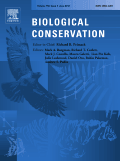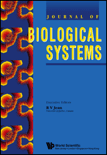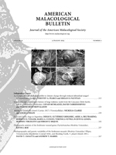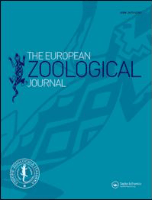
Russian Journal of Biological Invasions
Scope & Guideline
Connecting ecology and conservation through research.
Introduction
Aims and Scopes
- Ecological Impact Assessments:
The journal emphasizes research that evaluates the ecological effects of invasive species on native biodiversity, ecosystem functions, and habitat alterations. - Population Dynamics:
Studies on the population biology of invasive species, including their growth patterns, reproductive strategies, and interactions with native species, are a core focus. - Distribution Patterns:
Research detailing the geographic spread and distribution of invasive species, including environmental and anthropogenic factors influencing their range expansion. - Management and Control Strategies:
The journal publishes findings on effective management practices and control strategies for invasive species, including biological control, mechanical removal, and policy implications. - Genetic Studies:
There is a notable emphasis on genetic research related to invasive species, including studies on genetic diversity, population genetics, and the evolutionary implications of invasiveness. - Public Health and Economic Impacts:
The journal also addresses the broader implications of invasive species, including their effects on human health, agriculture, and economics.
Trending and Emerging
- Climate Change and Invasiveness:
Recent studies increasingly explore the relationship between climate change and the spread of invasive species, highlighting how changing environmental conditions facilitate invasiveness. - Ecosystem Services and Disservices:
The journal is seeing a rise in research that examines the dual roles of invasive species in ecosystems, both as providers of certain services and as disruptors of ecological balance. - Public Engagement and Citizen Science:
Emerging themes include the role of public engagement and citizen science in monitoring and managing invasive species, reflecting an increased interest in community-based approaches. - Genomic and Biotechnological Approaches:
There is a growing trend towards the application of genomic tools and biotechnological innovations in studying and managing invasive species, including DNA barcoding and gene editing. - Invasive Species and Human Health:
Research linking invasive species to public health issues is becoming more prominent, addressing the implications of biological invasions for disease transmission and food safety.
Declining or Waning
- Traditional Taxonomic Studies:
There has been a noticeable decrease in purely taxonomic-based studies of invasive species, as researchers increasingly focus on ecological interactions and management strategies rather than solely on species identification. - Invasive Species in Isolated Ecosystems:
Research on invasive species in isolated ecosystems, such as islands or specific protected areas, has become less frequent, possibly due to a shift towards studies that encompass broader ecological impacts. - Historical Invasion Studies:
There is a waning interest in historical accounts of invasions, with more contemporary studies emphasizing real-time monitoring and predictive modeling of invasive species dynamics. - Single Species Focus:
Research focusing on the impacts of single invasive species has decreased, as the journal increasingly favors studies that examine multi-species interactions and ecosystem-level effects.
Similar Journals

BIOLOGICAL CONSERVATION
Pioneering Insights for Effective Ecosystem Management.BIOLOGICAL CONSERVATION, published by Elsevier Science Ltd, is a leading international journal dedicated to advancing the science and practice of biological conservation. Since its inception in 1968, the journal has provided a critical platform for researchers, professionals, and students in the fields of Ecology, Evolution, Behavior, and Systematics as well as Nature and Landscape Conservation. With an impressive impact factor, and ranked in the Q1 category within both ecological and conservation domains in 2023, it emphasizes high-quality empirical and theoretical research essential for understanding and addressing pressing environmental challenges. Although it follows a subscription model, the journal is known for its rigorous peer-reviewed articles that contribute significantly to the field, ensuring that the latest findings and methodologies are readily accessible to practitioners. As a vital resource for those engaged in conservation efforts globally, BIOLOGICAL CONSERVATION stands out for its commitment to enhancing knowledge and informing strategies that safeguard biodiversity across ecosystems.

JOURNAL OF BIOLOGICAL SYSTEMS
Advancing interdisciplinary insights in biological systems.Journal of Biological Systems is a prestigious journal published by World Scientific Publishing Co. Pte Ltd that serves as a vital platform for interdisciplinary research in the domains of agricultural and biological sciences, applied mathematics, and ecology. With its inception in 1996 and converging insightful contributions up to the present, the journal showcases innovative research that influences both theoretical and practical aspects within these critical fields. Its commendable Q2 category rankings in 2023 highlight its commitment to high-quality scholarship, achieving rankings of #62 in Agricultural and Biological Sciences, #243 in Applied Mathematics, and #204 in Ecology on the respected Scopus index. While the journal maintains a traditional publishing model, its rigorous peer-review process ensures that it meets the highest academic standards. The Journal of Biological Systems is essential reading for researchers, professionals, and students keen to keep abreast of the latest developments and methodologies impacting ecological systems, mathematical applications, and biological innovations.

Management of Biological Invasions
Advancing the Science of Invasion ManagementManagement of Biological Invasions, published by the Regional Euro-Asian Biological Invasions Centre (REABIC), is a prominent open access journal that has been contributing to the field of ecological science since its inception in 2010. With an ISSN of 1989-8649 and a commendable presence in various ranking categories, it maintains a Q2 ranking in Ecology and Ecology, Evolution, Behavior and Systematics, as well as a Q3 ranking in Management, Monitoring, Policy and Law. This journal is vital for researchers, professionals, and students focused on understanding and managing biological invasions, a pressing issue that affects biodiversity and ecosystem health globally. Operating from Finland, “Management of Biological Invasions” fosters innovative research and facilitates discourse on management strategies through its rigorous peer-review process and dynamic publication schedule, ensuring accessibility for the academic community. As it converges years from 2010 to 2024, the journal continues to serve as a key platform for disseminating knowledge that informs policy, supports ecological resilience, and ultimately guides sustainable management practices.

AMERICAN MALACOLOGICAL BULLETIN
Illuminating the Ecological Importance of Mollusks.American Malacological Bulletin is a distinguished journal published by the American Malacological Society, Inc., dedicated to advancing the field of malacology, which encompasses the study of mollusks and their ecological significance. Since its inception, the journal has provided a vital platform for the dissemination of research findings, reviews, and significant contributions from both established and emerging scholars. With an ISSN of 0740-2783 and an E-ISSN of 2162-2698, it holds a global reputation within its niche, albeit recognized within the Q4 category in both Aquatic Science and Ecology, Evolution, Behavior and Systematics based on its 2023 ranking. The bulletin's focus on fostering dialogue and collaboration among researchers around the world underscores its importance within the scientific community. As a resource housed in the Delaware Museum of Natural History, it actively contributes to the ongoing conversation on ecological conservation, biodiversity, and the evolving challenges facing marine ecosystems. Though not classified as an Open Access journal, it remains accessible to scholars and students eager to explore contemporary research in malacology.

European Zoological Journal
Advancing the Frontiers of Animal ScienceEuropean Zoological Journal, published by Taylor & Francis Ltd, is an esteemed open-access publication dedicated to advancing the exciting field of zoology. Since its inception in 2017, this journal has progressively established itself as a vital resource for researchers, professionals, and students alike. With its Q2 ranking in Animal Science and Zoology as of 2023, the journal ranks in the 69th percentile among its peers, showcasing its influence and contribution to the discipline. The journal’s broad scope covers a wide range of topics within zoology, aiming to foster an understanding of animal biology and conservation efforts. As an open-access journal, it not only enhances the dissemination of knowledge but also encourages collaborative research across global communities. Situated in the United Kingdom, the European Zoological Journal invites submissions that contribute to the evolving discourse in animal sciences, and endeavors to support the scientific community in addressing pressing ecological challenges.

TRANSACTIONS OF THE AMERICAN FISHERIES SOCIETY
Connecting researchers with the essence of aquatic life.TRANSACTIONS OF THE AMERICAN FISHERIES SOCIETY, published by Wiley, is a leading journal dedicated to the field of fisheries science and aquatic ecology, with a rich history dating back to its inception in 1872. As an esteemed publication within the realms of Aquatic Science and Ecology, Evolution, Behavior, and Systematics, it currently holds a Q2 quartile ranking, demonstrating its significance and influence in these disciplines. The journal is not open access, which enables a curated peer-review process while ensuring high-quality research dissemination. The journal serves as a vital platform for scholars and practitioners alike, providing essential insights into the management and conservation of aquatic resources. Its commitment to addressing contemporary challenges faced in fisheries and aquatic environments makes it indispensable for researchers, professionals, and students seeking to contribute to this dynamic field.

PACIFIC CONSERVATION BIOLOGY
Empowering conservation through rigorous research and collaboration.PACIFIC CONSERVATION BIOLOGY is an esteemed academic journal published by CSIRO PUBLISHING, dedicated to advancing research in the fields of ecology and nature conservation. With a strong focus on the unique challenges and biodiversity of the Pacific region, this journal serves as a crucial platform for researchers, conservationists, and students alike to disseminate high-quality, impactful findings. Operating from Australia, it has become a significant resource since its inception in 1993, navigating through nearly three decades of vital scholarly communication. Ranked in the Q2 category for both Ecology and Nature and Landscape Conservation as of 2023, PACIFIC CONSERVATION BIOLOGY maintains rigorous standards, as reflected in its successful Scopus rankings. The journal plays a pivotal role in addressing pressing ecological issues and fostering innovative conservation strategies, making it an essential reference for anyone involved in environmental science. Access options for the journal facilitate widespread distribution of knowledge, supporting the mission to promote informed decision-making in conservation practices.

Alpine Entomology
Unveiling the Secrets of High-Altitude Insect LifeAlpine Entomology is a pioneering open-access journal published by Pensoft Publishers, dedicated to advancing the study of insect science and ecology, with a particular focus on mountainous environments. Launched in 2017 and accessible online, this journal provides a vital platform for researchers, professionals, and students to share their findings and insights in a rapidly evolving field. With its ISSN N/A and E-ISSN 2535-0889, Alpine Entomology has been recognized for its contributions, achieving Q3 category rankings in 2023 across several disciplines, including Animal Science and Zoology, as well as Ecology and Insect Science. Set in Sofia, Bulgaria, the journal exemplifies a commitment to promoting high-quality research and enhancing collaboration among scientists globally. Through its open-access model, it ensures that groundbreaking research is widely disseminated, helping to bridge gaps in knowledge and fostering a deeper understanding of alpine ecosystems and their intricate insect communities.

POPULATION ECOLOGY
Unraveling the complexities of biodiversity and conservation.Population Ecology is a leading journal dedicated to the advancement of research in the field of ecology, evolution, and behavior, published by the esteemed Wiley in Japan. With an impact factor indicative of its academic significance and ranked Q2 in the 2023 Ecology category, this journal serves as a pivotal resource for researchers, professionals, and students alike, facilitating the dissemination of high-quality research and innovative discussions. Covering diverse aspects of ecological dynamics, population processes, and their evolutionary implications, Population Ecology fosters a deeper understanding of species interactions and environmental factors shaping ecosystems. Available in both print and online formats (E-ISSN 1438-390X), the journal is committed to open access to enhance public engagement and accessibility to crucial scientific findings, ultimately contributing to informed decision-making regarding biodiversity and conservation efforts. With a robust ranking of #235 out of 721 in Agricultural and Biological Sciences, it is poised to remain at the forefront of ecological research through 2024 and beyond.

BULLETIN OF INSECTOLOGY
Unveiling the Secrets of Insect LifeBULLETIN OF INSECTOLOGY is a prominent academic journal published by ALMA MATER STUDIORUM, UNIV BOLOGNA, Italy, specializing in the field of Insect Science. The journal, with ISSN 1721-8861 and E-ISSN 2283-0332, has established itself as a vital resource for researchers and professionals interested in the diverse aspects of entomology and its applications. It ranks in the Q2 category for Insect Science as of 2023, placing it among the top journals in its field with a Scopus rank of 79 out of 181. The BULLETIN OF INSECTOLOGY is committed to disseminating high-quality research and innovative studies, facilitating open dialogue and collaboration among scientists. As an essential platform for sharing groundbreaking findings, it contributes significantly to the body of knowledge in agricultural and biological sciences, making it an invaluable asset for scholars and practitioners alike. With coverage from 2002 to 2024, this journal continues to foster advancements in entomological research and its importance in tackling environmental challenges.